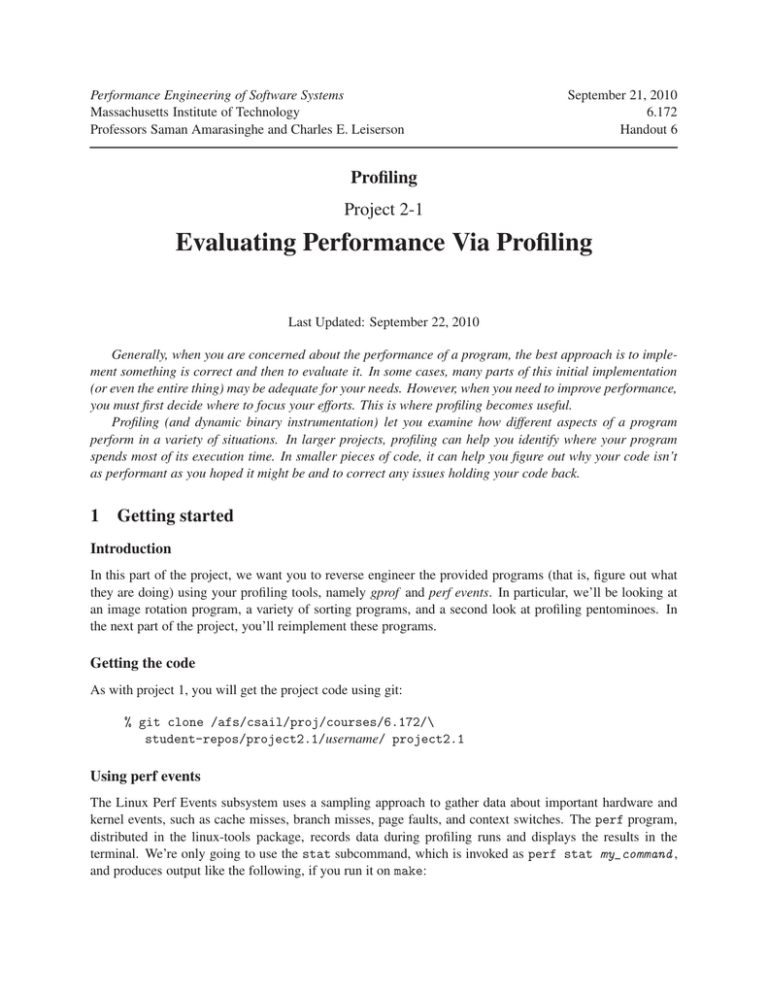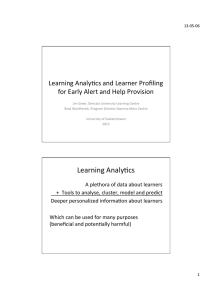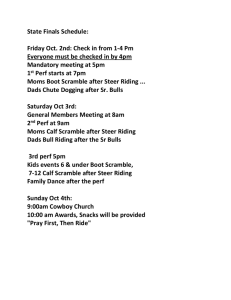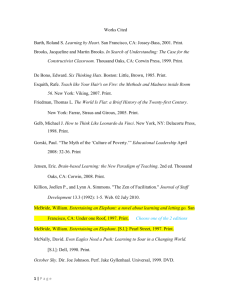Performance Engineering of Software Systems 6.172
advertisement

Performance Engineering of Software Systems
Massachusetts Institute of Technology
Professors Saman Amarasinghe and Charles E. Leiserson
September 21, 2010
6.172
Handout 6
Profiling
Project 2-1
Evaluating Performance Via Profiling
Last Updated: September 22, 2010
Generally, when you are concerned about the performance of a program, the best approach is to imple­
ment something is correct and then to evaluate it. In some cases, many parts of this initial implementation
(or even the entire thing) may be adequate for your needs. However, when you need to improve performance,
you must first decide where to focus your efforts. This is where profiling becomes useful.
Profiling (and dynamic binary instrumentation) let you examine how different aspects of a program
perform in a variety of situations. In larger projects, profiling can help you identify where your program
spends most of its execution time. In smaller pieces of code, it can help you figure out why your code isn’t
as performant as you hoped it might be and to correct any issues holding your code back.
1 Getting started
Introduction
In this part of the project, we want you to reverse engineer the provided programs (that is, figure out what
they are doing) using your profiling tools, namely gprof and perf events. In particular, we’ll be looking at
an image rotation program, a variety of sorting programs, and a second look at profiling pentominoes. In
the next part of the project, you’ll reimplement these programs.
Getting the code
As with project 1, you will get the project code using git:
% git clone /afs/csail/proj/courses/6.172/\
student-repos/project2.1/username/ project2.1
Using perf events
The Linux Perf Events subsystem uses a sampling approach to gather data about important hardware and
kernel events, such as cache misses, branch misses, page faults, and context switches. The perf program,
distributed in the linux-tools package, records data during profiling runs and displays the results in the
terminal. We’re only going to use the stat subcommand, which is invoked as perf stat my_command ,
and produces output like the following, if you run it on make:
Handout 6: Profiling
2
$ perf stat make -j
Performance counter stats for make -j:
8117.370256
678
133
235724
24821162526
18687303457
172158895
27075259
task clock ticks
context switches
CPU migrations
pagefaults
CPU cycles
instructions
cache references
cache misses
Wall-clock time elapsed:
#
#
#
#
#
#
#
#
11.281
0.000
0.000
0.029
3057.784
2302.138
21.209
3.335
CPU utilization factor
M/sec
M/sec
M/sec
M/sec
M/sec
M/sec
M/sec
719.554352 msecs
You can choose specific events, such as L1-dcache-load-misses, with the -e option. You can see a full
list of events by running perf list. For more examples of how to use perf, refer to the link below.
https://perf.wiki.kernel.org/index.php/Perf_examples
2 Image rotation
One of Snailspeed Ltd.’s larger consumer-facing services is the Snailsnap photo hosting service. Among
other things, Snailsnap lets users rotate their photographs. Since this is by far the most popular image
manipulation operation among users of the service (who are mostly professional photographers), any per­
formance improvements that can be made to the image rotation program will significantly reduce the number
of backend servers required by the service.
Each image is represented as a two-dimensional n × n matrix of 64-bit integers. Each integer contains
four channels of 16 bits each; the channels represent the red, blue, green, and alpha values of the pixel,
respectively. Each program creates a new n × n matrix which contains a rotated version of the original
matrix.
While you should be able to come up with a more efficient solution, a naive one might look something
like this.
• The matrix M is transposed, producing M T .
• Row i of M T is exchanged with row n − 1 + i.
In code, this simple solution would look something like this. The arguments m1 and m2 are the source
and destination matrices, respectively, and n is the length of one side of each matrix. Since C only sup­
ports one-dimensional arrays (as pointers into memory), we use a common technique to produce what is
effectively a two-dimensional array. Consider that a two-dimensional array can be mapped into a onedimensional array by laying out consecutive rows end-to-end in memory (so that a[n − 1] is the last element
of the first row, and a[n] is the first element of the second row). Let i = (y ∗ n) + x. Then, if b is the imaginary
two-dimensional matrix and a is the underlying one-dimensional array, you can access the element b[x][y]
by referring to a[i].
Handout 6: Profiling
3
1 void rotate ( const uint64_t * m1 , uint64_t * m2 , const int n )
2 {
3
for ( int i = 0; i < n ; ++ i )
4
for ( int j = 0; j < n ; ++ j )
5
m2 [( j * n ) + i ] = m1 [( i * n ) + ( n - 1 - j )];
6 }
Keep in mind that if you reverse x and y, this mapping will change! (You’ll be switching between a
row-major and a column-major layout.)
2.1
Run each of the three image rotation programs with n = 10, 000. You can do this for the nth program by
typing
pnqsub ./rotateN 10000
Report the execution time of each program.
2.2
From scribblings that Harvey left in the margin of the “high society” section of the Boston Globe, you learn
that rotate1 is the naive implementation presented above, and that rotate2 is exactly the same except
that the order in which the loops are nested has been reversed.
For each of the two programs, show the order in which the elements of the two matrices are accessed.
You should draw two diagrams, each consisting of two squares (one for m1 and one for m2). Use arrows to
depict the direction of memory accesses.
2.3
Draw an additional pair of diagrams for each of the two programs, showing how memory is accessed in
the one-dimensional array that is being used to represent the two-dimensional matrices. In your diagrams,
assume that memory is contiguous in the horizontal direction. Think about the difference in performance
between the two programs; do these diagrams provide you with any additional insight?
2.4
Assuming that the matrices are laid out in a single, contiguous block of memory, how do you think the cache
miss rates compare?
2.5
Verify your answer to the previous question by obtaining the exact L1 cache miss rates for both programs
using perf. Run the command below for both binaries, and report the cache miss ratio and the cycles per
instruction (CPI). The CPI is cycles divided by instructions, and the cache miss ratio is L1-dcache-load­
misses value divided by L1-dcache-loads.
% pnqsub perf stat -e cycles -e instructions ./rotateN
Handout 6: Profiling
4
% pnqsub perf stat -e L1-dcache-loads -e L1-dcache-load-misses ./rotateN
For CPI, the ideal value is about 0.25, since Core i7’s can dispatch about 4 instructions a cycle, and
lower is better. If you have lots of stalls, CPI may be above 1, meaning less than one instruction is retired
per cycle. For cache miss rates, the ideal miss rate is zero, and lower is obviously better.
Now, profile rotate3 and obtain its CPI and cache miss rate. Note that while the program’s internal
timer separates setup time from the execution time, the perf tool does not differentiate, and so the total
cache reference and miss numbers are polluted by setup. Therefore, the miss rate may not be as low as you
would expect it to be, even though the third program runs much more quickly.
2.6
Come up with a memory access pattern that might achieve the miss rate that you have observed. Draw the
same diagrams that you drew for the first two programs to illustrate this memory access pattern.
Hint: You should construct an access pattern that minimizes the miss rate as much as possible.
Hint: In class, we discussed techniques for revisiting cache lines before they are evicted.
3 Sorting 64-bit integers
Profiling code can often give you valuable insight into how a program works and why it performs the way
it does. In this exercise, you will be provided 4 unnamed sorting binaries (sort1 to sort4) and be asked
to infer what they do based on their performance characteristics. You may find it helpful to know that
these binaries were compiled with a highly optimizing compiler designed to take advantage of architecture­
specific features of the Intel Xeon processors in the cloud machines.
Note that we’ve provided int32_sorts and int64_sorts variants – these are all 64-bit programs, but
sort arrays of 32-bit integers and 64-bit integers, respectively.
Hint: Feel free to use general reference materials if you think they will help you.
3.1
Compare the first three 64-bit sorting programs by running them for arrays of 1, 000, 000 elements and
comment on their timing output.
3.2
Now, repeat the test for the 32-bit sorts. How does the performance differ?
Did any of the results surprise you? Can you think of possible explanations for your observations?
3.3
Use perf to obtain figures for the execution time, the CPI, the L1 data cache miss rate, and the branch
misprediction rate for each binary. For branch prediction, use the “branches” and “branch-misses” events.
Explain what each of these is, and what it measures. How does each impact performance? Briefly comment
on the results of your profiling.
Handout 6: Profiling
5
3.4
Comment on the trends you see. With the data you have collected, you should be able to identify what type
of sorting algorithm has been implemented in each of the first three programs; do so, and explain what led
you to each conclusion. If necessary, you are welcome to collect additional data points.
3.5
Now we will examine the final sorting program, sort4. This program is designed to sort very small arrays
quickly, so in order to obtain meaningful timing results we will have to run it a number of times. The second
argument to each sort program can be used to control the number of times the sorting algorithm is run. Run
the 64-bit version of each sorting algorithm for an array size of n = 7 for 10, 000, 000 iterations.
pnqsub perf stat ./sort4 7 10000000
What do you notice?
3.6
Now, run sort4 on input sizes of n = 6, 7, and 8. While doing so, use perf to inspect the L1 instruction
cache miss rate, using the following command.
pnqsub perf stat -e L1-icache-misses -e L1-icache-loads ./sort4 n 10000000
What do you notice?
3.7
Disassemble sort4 binary with the following command.
objdump -d sort4 > sort4.asm
Open sort4.asm with a text editor and find the beginning of the function named “b” by searching for the
string “<b>”. This function sorts an array of three elements. You may also want to look at “c”, which is
similar but sorts an array of four elements. Look at the size of these two functions; can you explain the
results of the previous section?
How does this program sort arrays?
4 Profiling pentominoes
For this exercise, we’ll be using gprof. Unlike perf events, gprof uses static instrumentation to gather
information about program execution. “Instrumentation” refers to bits of code that are inserted into the
program to record data. By “static” instrumentation, we mean that is inserted into the program by the
compiler. The tradeoff between event sampling and instrumentation is that sampling has low overhead and
uses performance counters, while instrumentation is more precise but has different overhead characteristics.
To use gprof, we have modified the Makefile to pass the -pg flag to the compiler and linker when
building your code, which instruments the binary. If you run make, it will print the command used to
Handout 6: Profiling
6
invoke the compiler, and verify that -pg is present. We also added -fno-inline-functions to prevent
the compiler from inlining all of the helper functions into solve_internal.
When you run your program, the instrumentation will count the number of calls to each function and
take timing and call stack samples. Recording a backtrace and checking a timer on every function call and
return is too expensive, so gprof uses a sampling based approach to gather this data, while the call count data
is precise. When the program exits, the profiling data is dumped to a gmon.out file in the current directory.
4.1
Gather and display the flat profile and callgraph from the instrumented pentominoes binary by running
% ./pentominoes -b ’0,0 1,1 2,2 3,3’ -n 1000
% gprof ./pentominoes
NOTE: You may have to scroll up to see the gprof output.
4.2
Suppose you could choose to optimize fill_piece to run 2x faster. Based on the data you have collected,
what would be the new runtime?
4.3
Perform the same computation for the can_fill_piece routine.
5 Turn-in
When you’ve written up answers to all of the above questions, turn in your writeup by uploading it to Stellar.
MIT OpenCourseWare
http://ocw.mit.edu
6.172 Performance Engineering of Software Systems
Fall 2010
For information about citing these materials or our Terms of Use, visit: http://ocw.mit.edu/terms.








